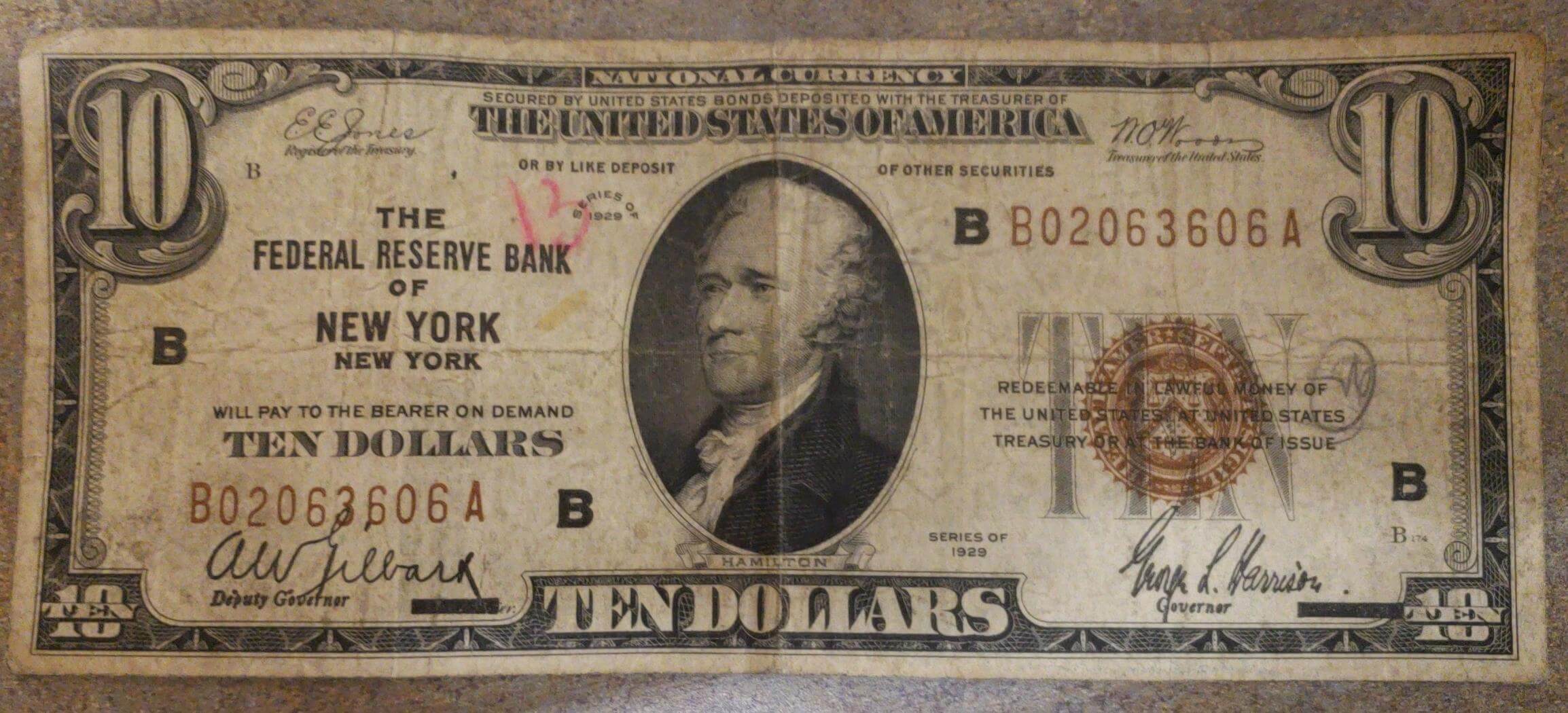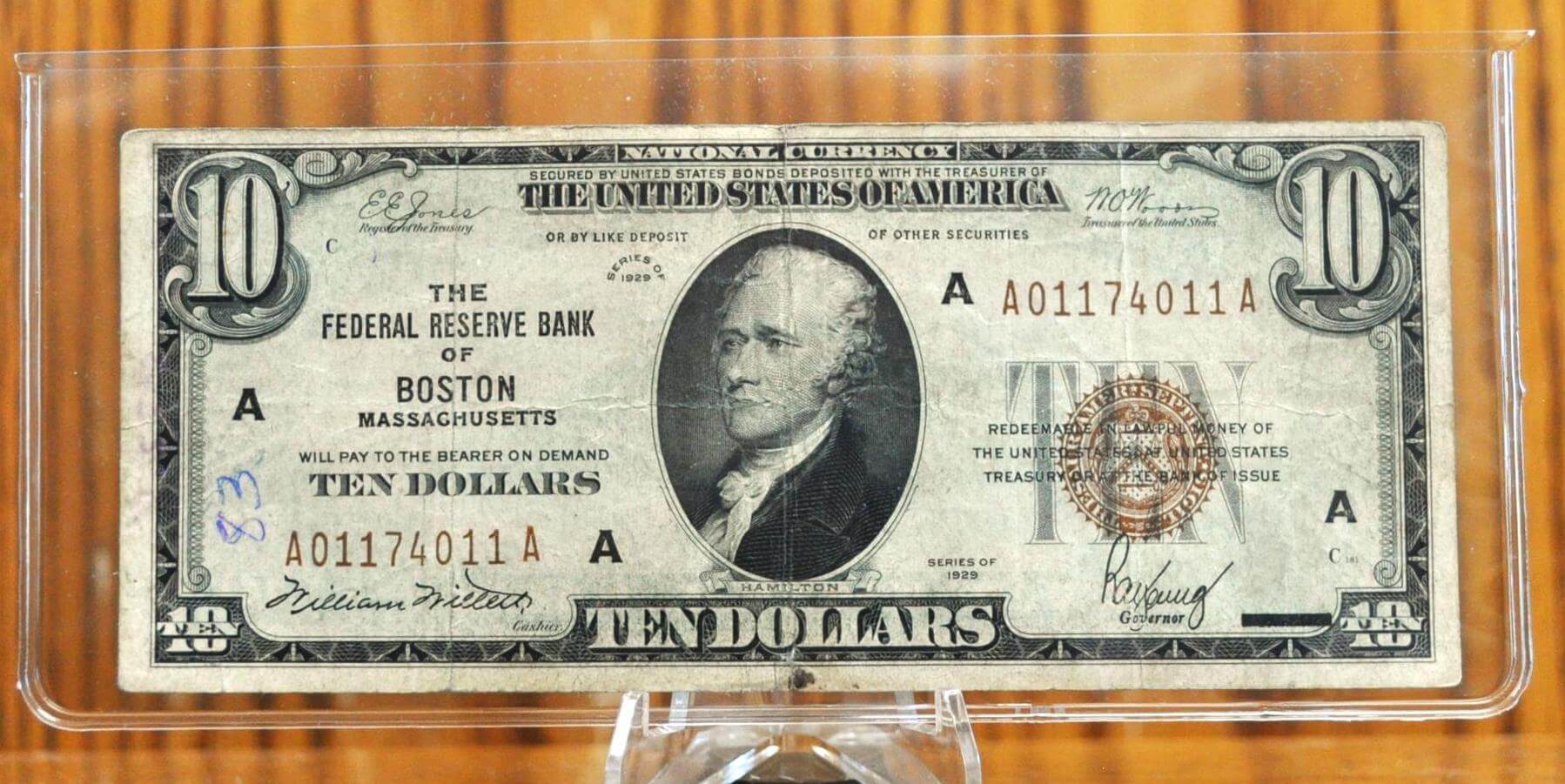The 1929 10 dollar bill is a fascinating piece of American history and currency, holding both financial and historical value. As with most collectible bills, its worth varies based on a variety of factors, including its condition, serial numbers, and whether it’s a Federal Reserve Note or a National Bank Note.
In this article, we will delve into the specifics of the 1929 $10 bill, explaining its design, types, and the key factors that determine its value in today’s market.
Overview Of The 1929 $10 Bill
The 1929 $10 bill is part of a larger series of currency known as the “1929 Series” issued by the U.S. Treasury. This series was introduced as part of the transition from large-sized to small-sized currency in the United States.
Prior to 1929, U.S. paper money was considerably larger, and the 1929 redesign aimed to streamline the design and make the bills easier to handle.

The 1929 $10 bill features Alexander Hamilton, one of the Founding Fathers of the United States, on the front. The reverse side is marked with the typical U.S. Treasury seal and the words “The United States of America” prominently displayed.
While the design on the bill remained fairly consistent, variations in the issuing bank, signatures, and serial numbers play a significant role in determining its value.
Types of 1929 $10 Bills
There are two primary types of 1929 $10 bills: **Federal Reserve Bank Notes** and **National Bank Notes**. Understanding these two types is crucial for anyone looking to evaluate the bill’s worth.
Federal Reserve Bank Notes
Federal Reserve Bank Notes were issued by the Federal Reserve Banks, which are the central banking system of the United States. These notes were part of a broad initiative to provide currency for the country’s expanding financial system.
On the front of the bill, you will see the name of the Federal Reserve Bank from which the note was issued, such as New York, Chicago, or Dallas.
Value of Federal Reserve Bank Notes
- Very Fine Condition: These bills are typically worth around $65. A bill in very fine condition shows some signs of wear but retains much of its original crispness.
- Uncirculated Condition (MS 63): In uncirculated condition, these notes can fetch around $200. Uncirculated notes are almost pristine, with no noticeable signs of wear, creases, or folds.
- Star Notes: Star notes, which have a star symbol instead of a letter at the end of the serial number, are especially valuable. Star notes are used to replace misprinted bills and are rarer than regular notes, often making them worth more.
- Rare Federal Reserve Banks: Bills issued from the Federal Reserve Banks of Dallas and San Francisco are particularly sought after by collectors. These bills can command higher prices, sometimes exceeding $300 depending on their condition.
National Bank Notes
National Bank Notes were issued by national banks, which were privately chartered banks that were part of the federal banking system. Unlike Federal Reserve Bank Notes, National Bank Notes feature the name of the issuing bank on the front of the bill. There are two types of 1929 $10 National Bank Notes: **Type 1** and **Type 2**.
Type 1 vs. Type 2 National Bank Notes
The main difference between Type 1 and Type 2 National Bank Notes is the placement of the bank charter number. In Type 1 notes, the bank charter number is not present, while in Type 2 notes, the bank charter number is located at the lower left and upper right of Hamilton’s portrait on the front of the bill.
Value of National Bank Notes
- Type 1 Notes: These are generally worth around $75 in very fine condition. In extremely fine condition, the value can rise to $100. Uncirculated Type 1 notes, graded MS 63, can be worth around $225.
- Type 2 Notes: Type 2 notes tend to be a bit more valuable. In very fine condition, they are worth around $80. When in extremely fine condition, they can reach around $105. Uncirculated Type 2 notes with an MS 63 grade can be valued at $250 or more.
Key Factors Affecting the Value of a 1929 $10 Bill
Several factors play a significant role in determining the value of a 1929 $10 bill. These factors include its condition, rarity, serial number, and the bank of issue. Below, we will dive into each of these elements to help you understand how they influence the bill’s worth.

Condition
Condition is one of the most important factors when evaluating a bill’s value. The grading system for U.S. currency typically includes several classifications:
- Very Fine (VF): A bill in very fine condition has been in circulation for a period but is still relatively crisp. There may be some creases, folds, or light smudges, but the overall design is still visible.
- Extremely Fine (EF): This condition shows minor signs of wear, but the bill is still bright and nearly crisp. There may be one or two small creases or folds, but there are no stains, discolorations, or tears.
- Uncirculated (MS 63): An uncirculated bill is essentially as good as new. It has never been folded or creased and retains its original crispness. These bills command the highest prices, especially when graded MS 63 or higher.
Serial Numbers
Another significant factor that influences the value of a 1929 $10 bill is its serial number. Collectors often look for certain types of serial numbers, which can make a bill more valuable:
- Star Notes: As mentioned earlier, star notes are those with a star symbol at the end of the serial number. These notes are considered rarer and more valuable because they were issued to replace defective bills.
- Low Serial Numbers: Bills with serial numbers that start with several zeros (e.g., 000001 or 000007) are often considered more collectible. These low serial numbers are seen as more historically significant and can increase the bill’s value.
- Repeating Serial Numbers: Bills with repeating serial numbers (e.g., 12341234) are also prized by collectors, as they are perceived as more unique and desirable.
Bank of Issue
The bank that issued the bill also plays a role in its value. Certain Federal Reserve Banks and National Banks are more well-known or rarer than others, making the bills issued by those banks more valuable.
For example, bills from the Federal Reserve Bank of Dallas or San Francisco can fetch higher prices due to their relative rarity.
Star Notes and Other Variations
In addition to the factors above, star notes, as previously discussed, can significantly boost the value of a 1929 $10 bill. These notes are produced in small quantities and are typically in better condition than regular notes, making them highly sought after by collectors.
Additionally, bills with unique features, such as rare signatures or unusual serial numbers, can also command a premium price.
Conclusion
The 1929 $10 bill is more than just a piece of currency; it is a piece of American history. Whether you’re a collector looking to add a valuable note to your collection or simply curious about the worth of an old bill you found in a drawer, understanding the factors that determine its value can help you make informed decisions.
If you have a 1929 $10 bill, it’s essential to consider its type (Federal Reserve Bank or National Bank), condition, serial number, and issuing bank. While most 1929 $10 bills are not exceptionally rare or valuable, those in excellent condition or with unique features can command high prices. Star notes, bills with low serial numbers, and notes from less common banks are particularly sought after by collectors.
For anyone interested in purchasing or selling a 1929 10 dollar bill, it’s always a good idea to consult with a currency expert or appraiser to get a precise valuation based on the bill’s specific characteristics.

